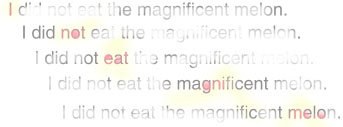

 |
Greg Kochanski |  |
"How much of language is fixed by our anatomy, and how much is cultural?"
"How much of language is consciously accessible?"
Are there answers? Well, yes and no. They are open research questions, and there certainly aren't any final answers, but there are some partial answers or interesting findings.
Those two questions overlap both prosody and the more wordy "lexical" parts of speech. But, there's more to language than prosody and ASR systems, too. Language extinction and language evolution are fields that deal with the wordy side of language but don't involve software and systems.
The first question, anatomy vs. cultural, is a broad question that applies to words as well as prosody. People attack it from two ends: one one side, you can look at a whole collection of languages and see what is common and what is variable. The common parts are things that could be hard-wired into our genes or brains; the variable parts are things that are likely to be cultural.
The trouble with that kind of cross-linguistic survey approach is that
So, I prefer the bottom-up approach, where you try to figure out how the brain works, what it can do and what it can't do. Then, if you understand things, you can start to say things, and make predictions.
For instance, one interesting bit of work that I've done involved building mathematical models of Mandarin Chinese intonation. Mandarin is a tone language, which means that the same syllable (e.g. ma) can mean several things, depending on whether you say it with a high tone, low tone, rising tone, or falling tone. So, the one-syllable word, "ma" can mean "mother", "horse", or "to scold". There's a Chinese children's tongue-twister ("Mother scolds the horse"/"The horse scolds mother") that makes use of this. So, tone is important. If you get the wrong tone, sometimes you'll be intelligible but sound confused, but sometimes you'll be misunderstood.
Chilin Shih and I were looking at writing software to synthesize the tone shapes, and we rapidly realized that some pairs of tones were physiologically impossible: by the time you got around to manouvering the muscles in your larynx to get from the end of one tone to prepare for the beginning of another, the syllable would be just about over. Think of a pair of falling tones on successive syllables. In the brief interval, you need to re-arrange your larynx to go all the way from a low pitch, up to a high pitch, then reverse the direction of motion to be falling when the next syllable commences.
The trouble is, you can't do it. Especially so, since the laryngeal muscles are relative slowpokes compared to the tongue and jaw. You can't do it, but you have to do something. There was a classic moment where we were busily scribbling on a paper napkin, realizing what the problem was and the right approach to solving it.
We started using some math that physiologists and experimental psychologists use to describe motions of the arms and legs, and it worked fairly well, but only after we tied it into some more linguistic knowledge. Many (or most) languages have some kind of rough alternation of strong and weak syllables (one almost never sees two strong syllables next to one another). This turns out to be crucial to Mandarin tones. In strong syllables, you take care to execute the correct tone shape carefully. These tend to be important words, and the beginnings of words, sentences and phrases. (Beginnings are important, because you're trying to get your listener started on your train of thought; once he/she has a start, the listener can use context to fill in some missing tone information.)
Now, in weak syllables, we found that the speaker produces sloppy tone shapes, but sloppy in a very predictable way. These weak syllables are used to prepare for the next strong syllable, rather than to carry their own tone information. For instance, a weak falling tone that is sandwitched between a strong low tone and a strong high tone might end up appearing to be a rising tone, because that time is being used to prepare for the next important syllable. (Weak syllables tend to be words line "a" and "the", or the second syllable in polysyllabic words like "Poland")
So, that's a story where understanding some physiology lets you deduce some properties of any tone language. Certain bits of Mandarin are clearly set by our anatomy. Any tone language that has mutually incompatible tone shapes needs a pattern of strong and weak syllables (or a few other possibilities: the language could introduce pauses or lengthen certain syllable combinations to give the muscles time to get positioned).
And, that ties into prosody too, because the same control mechanism in the brain that does strong and weak syllables seems to be used for emphasis and (in Mandarin) for implementing certain types of questions.
| [ Papers | kochanski.org | Phonetics Lab | Oxford ] | Last Modified Thu Sep 1 11:10:21 2005 | Greg Kochanski: [ Home ] |